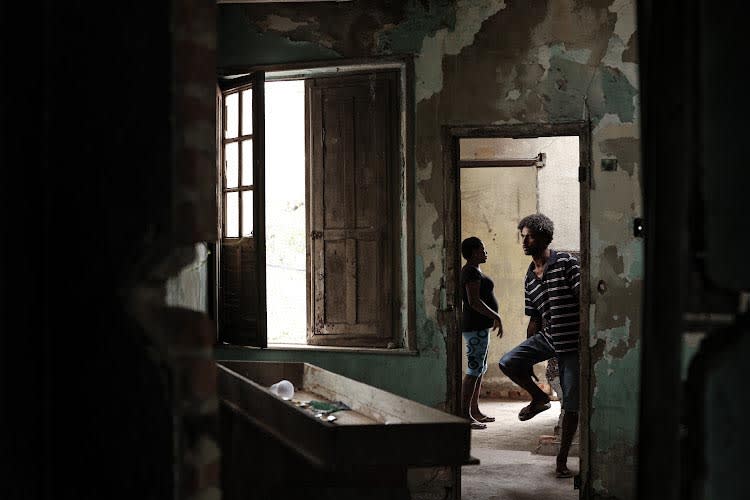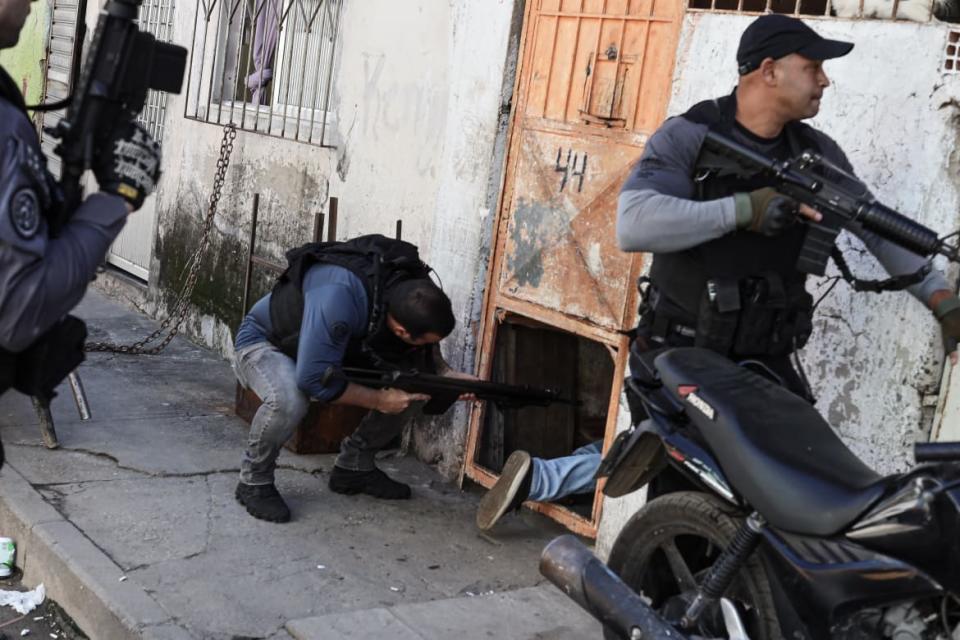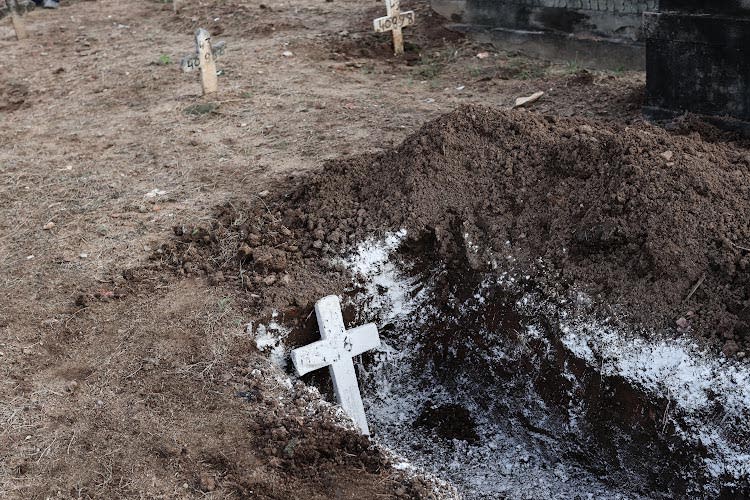How America Created a Gun-Happy Gangster’s Paradise in Brazil

RIO DE JANEIRO—Thousands of made-in-America weapons are pouring into Brazil and landing straight into the hands of gangsters every day, and the U.S. is failing miserably at stemming the flood.
According to the United Nations Office on Drugs and Crimes (UNODC), Brazil is home to roughly 8 million illegal weapons, more than half of which were smuggled from the U.S. The latest U.N.-sponsored report suggests that a little under 20,000 American weapons enter Brazil each year.

It is estimated that over 300,000 addicts currently live on the streets of Rio de Janeiro. While most use crack, heroin also has found its way on the streets of Rio. This biblical number is most likely an underestimate since no real research has been done inside all the various favelas.
In Rio de Janeiro, local authorities believe that around 4,000 new illegal weapons arrive in the city each day. About a quarter of those are assault rifles, according to Christiano, a high-ranking Military Police commander in Rio de Janeiro who oversees operations to capture illegal guns off the streets.
“Once these weapons cross our national borders, we almost have no way to capture these guns before they end up in the wrong people’s hands,” Christiano told The Daily Beast.
Brazilian authorities working to contain the arrival of these weapons at the two main harbors serving Rio de Janeiro and São Paulo are gravely under-resourced. And meanwhile, instead of helping curb the country’s influx of dangerous weapons, the U.S. has focused most of its efforts on pressuring Brazil to fight its illegal drug trade, forcing Brazilian authorities to relocate their meager resources to the war on drugs and leaving an open alley for gun-runners to infiltrate Brazil’s main commercial ports. “The U.S. government is worried about its domestic drug addiction issues, so it has put pressure on my country’s government to focus mostly on the drug trade instead of illegal weapons business,” an officer from the Secretaria Estadual de Policia Civil, Brazil’s civil police, explained.
The consequences of this crisis are severe. In Rio de Janeiro, one of the most dangerous cities on the planet, murder rates have been skyrocketing, from 925 in 2016 to 1,814 in 2019, the AP reported. The majority of those murders involve the use of smuggled firearms. In fact, corruption is so rampant in the city that gangs are able to buy off workers in order to let their cargo enter Brazil easily. Once these weapons are unloaded, they are funneled through the country to other gang-controlled areas, mostly in São Paulo, Fortaleza, and the state of Amazonia, Christiano explained.

A small unit of civil police is conducting an operation in a very dangerous favela of Northern Rio to catch a well-known drug dealer. Clashes soon errupted between various other police units and armed gang members.
In order to understand how the illicit weapons trade functions, one has to see it as a global business with many different actors and consumers, spreading its tentacles from various points of origins, mostly within our borders to their final destination in Mexico, Paraguay, and Brazil. Arms dealers will go to great lengths to protect their macabre business, securing trade routes often stretching from one continent to the next, creating constant flows of weapons and ammunition to our Southern neighbors.
Two main trade routes exist today. Both originate from America’ southern states, which produce a staggering amount of firearms each year. Today, roughly 393 million guns are held within U.S. borders. The ATF, on the other hand, has little idea how many of these weapons leave American shores to be resold illegally to Mexico, Central America, and South America. In fact, the ATF “does not maintain a federal gun registry, therefore, records are not kept on the sales of firearms, private sales or individual purchasers,” a spokesperson told ABC News.

A priest is waiting in a car, , his Bible inside the hot favela of Trabajaras. These priests go around the favelas blessing people, especially gang members.
Despite their efforts, U.S. authorities are barely making a dent in the illicit gun trade. It is estimated that each year the various agencies involved are only able to confiscate 10 percent to 15 percent of illegal firearms worldwide, according to ex-ATF agent Joe Anarumo. “We are barely scratching the surface,” he told The Daily Beast.
But there have been some success stories.
In March 2019, HSI was tipped off by their Brazilian counterparts about a weapon-smuggling ring that was exporting assault rifles and ammo to São Paulo from the United States. So alarming was the efficiency of the arrival of these weapons into the hands of various gangs like Comando Vermelho (Red Command), or Amigos dos Amigos, that the Brazilian government coordinated its efforts with the DEA. As a result, key members of a major criminal organization were arrested, all Brazilians holding U.S. passports.
His Name Is Barbecue—and He’s Ready to Plunge Haiti Into War
Frederik Barbieri, a Brazilian national better known as the Lord of Guns and one of the most prolific gun smugglers, was finally arrested in the summer of 2018. He was smuggling all types of firearms, ammunition and explosives to Rio de Janeiro, using containers to hide his illicit cargo. The few weapons that were caught by U.S. authorities were found in the most unlikely places, like water heaters and swimming pool pumps. Barbieri was making so much money that the U.S. government is still unclear about the extent of his empire’s financial power. The Lord of Guns received a 12-year sentence for his crimes, stopping one of the most successful gun runners in recent years.
The ex-ATF agent, Anarumo, explained that a strategy similar to Barbieri’s is employed by cartels and gangs from Mexico to Brazil.
It’s simple. First, the criminal organization will contact their associates already in the U.S., holding American passports. Once they receive their orders, the stringers will go to Florida, Arizona, New Mexico, or Texas, where it’s easy to buy handguns and assault rifles. Once the purchase is made at local stores, some of these weapons will be dismantled, hidden away in creative containers like refrigerator filters, and driven to Miami. Then, once these weapons are loaded in containers and onto ships, some go straight to South America, while a small minority are directed towards Haiti and the Dominican Republic to supply gangs operating on Hispaniola, which has become a major hub for illicit drugs and weapons smuggling.

A famous martial art teacher from a northern favela of Rio was shot in the face by police during a shootout with gang members. Whether or not he was at the wrong place at the wrong time, his popularity brought hundreds of locals to his funeral. This man is just another casualty of the ongoing fight between powerful gangs and the government.
“The other big challenge for us is to be able to coordinate with our counterparts in these Latin countries,” the ATF agent said. “Because once these weapons leave our shores, we have little leverage to force or convince them to help us.”
Speaking with The Daily Beast, a former high-ranking DEA officer, Paul Campo, described the weapons crisis as a “losing battle.” The opponents, he said, are “ever-changing, powerful criminal organizations who have the advantage to follow no rules, and can adapt to any situation in order to evolve.”
Get our top stories in your inbox every day. Sign up now!
Daily Beast Membership: Beast Inside goes deeper on the stories that matter to you. Learn more.

